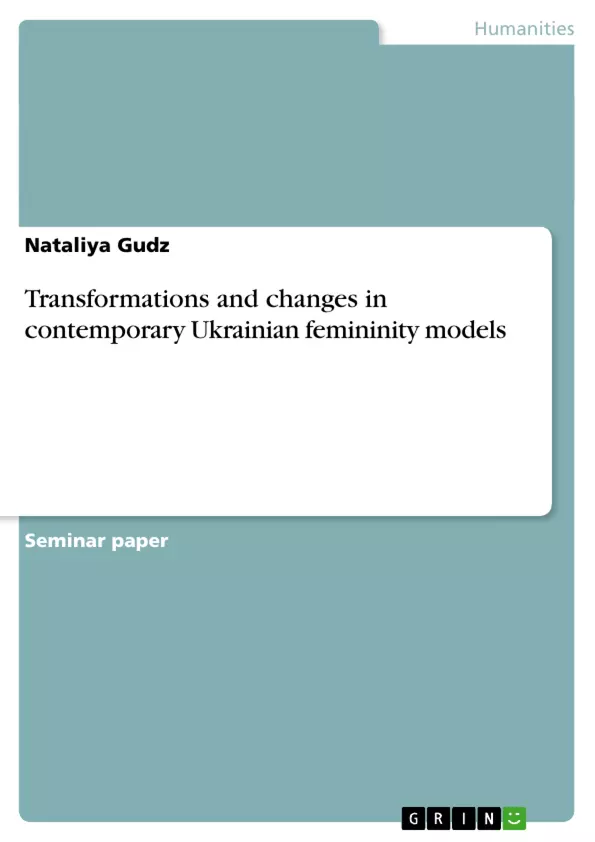After the declaration of the Ukrainian independence and fall of the “iron curtain” the awareness of the Ukrainian women was drastically changed. Ideologically guided canon of femininity – “a Soviet super-woman” as “a working mother” – has lost its actuality; in the 1990s it was changed by new life standards, behaviour models, values and moral norms. At once the nationalist movements appeared on the scene and demanded to design and maintain national identity with articulation of basic concepts of nationality. In Ukraine this process was socially defined through the modern reconstruction of patriarchy supported by the educational system, mass media, political discourse, and legislation. Having recognised Ukrainian as the official language, Ukraine began moulding ideology constructed on the conception of the pre- Revolutionary Ukraine. The entangled images of the Cossack republic and the image of Ukraine as Mother, together with vital revival of Orthodoxy, strengthened patriarchy in politics, social order and cultural structures of the modern Ukrainian society. However through economical crisis and society instability, the image of Mother-Protector correlated with the historical past and traditional culture of the Ukrainians was shifted from its key position by unfamiliar before, but rather appealing “Western models of femininity”. In this paper we try to find out how all these images of femininity were created, maintained and transformed through the recent years.
Inhaltsverzeichnis (Table of Contents)
- Introduction
- 1. Transformation of the old Soviet gender traditions into the new Ukrainian surrounding
- 2. A woman as embodiment of the national identity – Mother-Protector
- 3. Western models of femininity
- 3.1. A supported woman - Barbie
- 3.2. An independent woman - Business Woman
- Conclusions
Zielsetzung und Themenschwerpunkte (Objectives and Key Themes)
This paper examines the evolution of femininity models in contemporary Ukraine, tracing the transition from Soviet-era ideals to the emergence of new identities influenced by both national narratives and Western trends. The study explores the complex interplay of societal, political, and cultural factors that shaped these transformations.
- The impact of the collapse of the Soviet Union on Ukrainian gender roles and the creation of a new national identity
- The construction of the “Mother-Protector” image as a symbol of Ukrainian femininity and its relationship to historical, religious, and cultural traditions
- The influence of Western models of femininity, specifically the "Barbie" and "Business Woman" archetypes, on Ukrainian women’s aspirations and self-perception
- The role of the Ukrainian educational system, mass media, and political discourse in shaping gender norms and perceptions
- The enduring influence of traditional patriarchy and its impact on Ukrainian society
Zusammenfassung der Kapitel (Chapter Summaries)
The first chapter analyzes the transformation of Soviet gender traditions within the context of newly independent Ukraine. It explores how the Soviet ideal of the "working mother" was challenged by new life standards, values, and norms. This chapter also highlights the role of the Ukrainian educational system in perpetuating traditional gender roles, even in the early years of independence.
The second chapter examines the emergence of the "Mother-Protector" as a dominant image of Ukrainian femininity. This image, rooted in historical, religious, and cultural elements, aimed to represent the strength and resilience of Ukrainian women. This chapter explores the relationship between this image and the rise of patriarchy in post-Soviet Ukraine.
Schlüsselwörter (Keywords)
The key concepts explored in this paper include Ukrainian national identity, gender roles, femininity models, patriarchy, Soviet legacy, Westernization, cultural transformation, Mother-Protector, Barbie, Business Woman, Ukrainian education system, and political discourse.
- Citar trabajo
- Nataliya Gudz (Autor), 2004, Transformations and changes in contemporary Ukrainian femininity models, Múnich, GRIN Verlag, https://www.grin.com/document/32691



